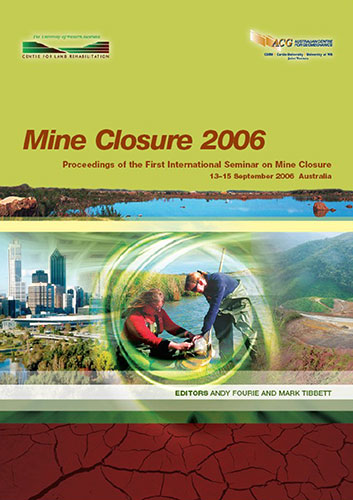Mine Closure as a Driver for Waste Rock Dump Construction

|
Authors: Williams, DJ |
DOI https://doi.org/10.36487/ACG_repo/605_61
Cite As:
Williams, DJ 2006, 'Mine Closure as a Driver for Waste Rock Dump Construction', in AB Fourie & M Tibbett (eds), Mine Closure 2006: Proceedings of the First International Seminar on Mine Closure, Australian Centre for Geomechanics, Perth, pp. 697-706, https://doi.org/10.36487/ACG_repo/605_61
Abstract:
Waste rock dump construction is driven largely by the costs associated with hauling the rock. In recent times, there have been large increases in certain costs associated with conventional haulage; namely, the cost of diesel and the cost and restricted availability of new tyres. These cost pressures have impacted on the balance between horizontal and vertical haulage, affecting the areal extent and height of the dump. Dumps tend to be expanded, both upwards (by additional lifts) and laterally, in stages. There has been little incentive to progressively cover the waste rock dump during construction, since the dump is kept active to accommodate expected and possible expansion of the mine and Net Present Value accounting promotes delayed mine closure. Increasingly, other drivers are coming to the fore, including mine closure requirements. These include the need to encapsulate, with benign waste rock, potentially acid forming waste rock; the need to limit potentially contaminated seepage from the dump; and the need to limit erosion loss off the dump. Since benign waste rock may only be produced during the early stages of open pit mining, there is the risk that it will be buried beneath deeper-won potentially acid forming waste rock, leaving no benign material with which to encapsulate the potentially acid forming waste rock. Potentially acid forming waste rock needs to be placed beneath the flat top surface of the dump, and the relative proportions of benign and potentially acid forming waste rock will dictate the dump width to height ratio, and the final angle of the outer batters of the dump, that makes this possible. By keeping the dump active throughout the mine life, rainfall and oxygen are free to infiltrate the dump, leading to the wetting up of the dump and the oxidation of potentially acid forming waste rock. Even after an effective rainfall percolation-limiting cover has been placed on the dump, the water stored within the dump during its operation will continue to seep at a diminishing rate for many years, carrying with it any oxidation products. The conventional practice of placing a fine-grained growth medium on the steep side slopes of the dump often leads to unacceptably high rates of erosion loss. The paper presents refined approaches to waste rock dump construction driven by mine closure requirements.
References:
Fredlund, M.D., Fredlund, D.G. and Wilson, G.W. (1997) Prediction of the soil water characteristic curve from grain
size distribution and volume mass properties. Proceedings of Third Brazilian Symposium on Unsaturated Soils,
Rio de Janeiro, Brazil, 22-25 April 1997, 12 p.
Fredlund, D.G. and Rahardjo, H. (1993) Soil mechanics for unsaturated soils. John Wiley and Sons, New York.
Fredlund, D.G. and Xing, A. (1994) Equations for the soil-water characteristic curve. Canadian Geotechnical Journal,
31, pp. 521-532.
Fredlund, D.G., Xing, A. and Huang, S. (1994) Predicting the permeability function for unsaturated soils using the soil
water characteristic curve. Canadian Geotechnical Journal, 31, pp. 533-546.
Scott, P. (2005) Private communication.
Williams, D.J. (2006) The case for revolutionary change to mine waste disposal and rehabilitation. Proceedings of
Second International Seminar on Strategic versus Tactical Approaches to Mining, Perth, Australia, 8-10 March
2006, 19 p.
Williams, D.J. and Rohde, T.K. (2006) Rainfall infiltration-induced seepage from waste rock piles. To appear in
Proceedings of Water in Mining 2006, Brisbane, Australia, 14-16 November 2006.
Williams, D.J., Stolberg, D.J. and Currey, N.A. (2006) Long-term performance of Kidston’s “store/release” cover
system over potentially acid forming waste rock dumps. Proceedings of Seventh International Conference on
Acid Rock Drainage, St Louis, Missouri, USA, 26-30 March 2006, pp. 2385-2396.
Williams, D.J., Wilson, G.W. and Currey, N.A. (1997) A cover system for a potentially acid forming waste rock dump
in a dry climate. Proceedings of Fourth International Conference on Tailings and Mine Waste ’97, Fort Collins,
Colorado, 13-17 January 1997, pp. 231-235.
Mine Closure as a Driver for Waste Rock Dump Construction D.J. Williams
706 Mine Closure 2006, Perth, Australia
© Copyright 2025, Australian Centre for Geomechanics (ACG), The University of Western Australia. All rights reserved.
View copyright/legal information
Please direct any queries or error reports to repository-acg@uwa.edu.au
View copyright/legal information
Please direct any queries or error reports to repository-acg@uwa.edu.au